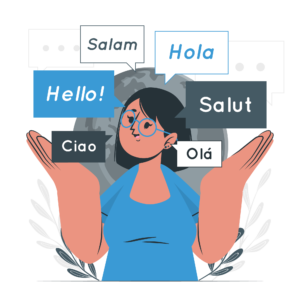Definition
A communication system structured in vocabulary and grammar expressed through sounds, symbols, gestures, and other non-verbal cues. Language is passed on generationally and identifies people as a group. Most languages develop a written script.

Story: I Don’t Understand My Teacher
Lila grew up in a small village nestled in the mountains. It was her first day of class, and her father took her to school in the next town.
Lila: I don’t understand what the teacher is saying.
Classmate: She is using our national language. My parents speak it at home, so it’s easy for me.
Lila: But my parents never use it at home. I don’t know any other language except the one we use at home.
Teacher: Class, can anyone tell me what 2 + 2 equals?
Classmate: Four!
Lila (embarrassed and crying): I miss home. This is too difficult.
But despite the difficulties, Lila studied hard and adapted to the national language. The teacher was also very patient with her.
Lila: I’m starting to understand more after the first few weeks. It’s not so difficult anymore.
Classmate: That’s great, Lila! I am happy for you.
One day Lila asked her teacher.
Lila: Why don’t we use our own language in school?
Teacher: Because the textbooks are in the national language and when you graduate and must find a good job in the city, you must master our national language.
Examples from the Bible
- People had one language, became proud, and wanted to build a tower to heaven. God saw it and confused their languages so they would not understand each other anymore, causing them to spread throughout the world in their language groups (Genesis 11:1-9).
- Joesph immediately knew his brothers when they came to him to Egypt to buy grain. Still, Joseph did not reveal himself at first and used an interpreter. His brothers spoke among each other in their own language, assuming Joseph did not understand them (Genesis 42:6-7+23, 45:12).
- The Ephraimites were defeated and desired to return home, crossing the Jordan, but hoped to be identified as Gileadites. However, they were detected due to their failure to pronounce the word shibboleth in a Gileadite manner. Because of that, they took the impostor and slew him at the passages of Jordan (Judges 12).
- King Hezekiah, during the Assyrian invasion, faced the threat from the Assyrian king’s representative, Rabshakeh, who addressed the people of Judah in their own language and tried to instill fear (2 Kings 18:17-37).
- Those Jews living in other countries outside Jerusalem were surprised to hear the disciples of Jesus speaking their own language. They acknowledge those distinct languages that identify each country where they live, such as Parthia, Media, and Elam. Others are from Mesopotamia, Judea, Cappadocia, Pontus, Asia, Phrygia, Pamphylia, Egypt, and parts of Libya near Cyrene, Rome, Crete, and Arabia. According to verse 11, some of them were born Jews, and others have chosen to become Jews. Yet they all hear them using their own languages to tell the beautiful things God has done (Acts 2).
Real-life examples
- East Timor Language, Tetum, was just an oral language before being proclaimed an independent nation in 1999. It became a written language developed by the University of Sydney. Those who are exposed to LOR methods, such as new government officials who studied abroad or students who have followed the Indonesian system of education, would prefer to use their new Tetum, that has much influenced by LOR Portuguese language and the Bahasa Indonesia, which is already influenced (and mixed) with Dutch and Arabic languages. Most HOR people would use the original oral language without referring to the more constructed grammar and alphabet, which is LOR.

- The Like👍🏽 button on social media made the thumbs-up sign almost globally mutually understandable. However, for some people groups, it meant something different before globalization unified its meaning.
- Indonesians in Jakarta (and increasingly those in the capital of each province of Java) would prefer to mix the English language with their national language Indonesians in some instances like social gatherings, church services, educational system, marketing, etc. These LOR methods are preferred in their daily conversation, whereas HOR methods are still much of the rural areas.

Discover more about Language through our training materials on the I-OS website!
Relevance

Language is the primary way of communicating ideas, learning, and passing on information. It has a profound impact on culture and how people learn. Language is also a significant source of miscommunication and misunderstandings. Especially when we think to understand the other person, but the same terms and sentences mean something different to them.
Non-verbal communication and even sign language are important topics of study because they are not universal.
Language is a bridge to connect with a particular group of people we aim to reach. It is one way for a missionary to convey the Good News through verbal ideas they will understand. Since language is a significant identity of a people group, it is paramount for a minister to know and learn the language of his host culture.
Orality preference continuum
The continuum between HOR and LOR is not so easy to define for this trait of orality. While most HOR cultures use a trade language in formal education, i.E. Germans use their own language and do not rely on a trade language. The same would apply to many influential languages with much of their own literature.
Still, there is a clear tendency of HOR people to rely mostly on their own dialect for non-formal education. At the same time, they use a trade language in formal education.
Another differentiator is that, unlike HOR cultures, LOR people tend to put a much greater emphasis on correct grammar.
Let us look at the table with examples below for a more nuanced differentiation.
| Very high | High | Low | Very low |
|---|---|---|---|
| People would prefer to use their own dialect (mother tongue) in most conversations or formal talk. | People would use their dialect appropriately depending on who they are talking with. | People would simultaneously mix their own and a foreign language in most conversations and formal talk. | People prefer to use a foreign language primarily in conversations and formal talks. |
| Education is primarily informal and oral, using the local language only. | Most education is primarily local and only uses some books and a few terms from trade language. | Education is primarily formal and mainly in the trade language, but students still prefer the local language. | Education is formal and is primarily done in trade language, and textbooks are mostly imported. |
What has been discovered?
Language is the criteria to identify the indigeneity of indigenous people groups. While they may adapt to a dominant culture in many ways, their language usually retains their own words, such as in pidgin or pigeon, Taglish (Tagalog/English).1
Dialects are a variation of accents with various differences in grammar and common words and expressions. It identifies who belongs to “us” and who is “them.”2
Language, at one level, is a set of symbols representing the realities around us. They bring us to mutual understanding yet can only be more completely understood through non-verbal languages.3 This is part of the reason print/text can never fully communicate one’s thoughts – in terms of orality, our inner speech.
Language is dynamic – constantly changing – which makes static textual translation a more significant challenge than we are willing to admit.4
Additional resources
- The Expanded Graded Intergenerational Disruption Scale developed by Lewis and Simons, 2010 measures the vitality level of languages.
- A playlist of short language videos by Tom Scott. Could Shakespeare have been French?
- A fun video about computer-generated translation. I made sushi, but the recipe was translated 60 times.
- Some languages are going extinct. Are We Losing Our Language?
- Agoos, Ella. “Linguistic Essentialism and Indigenous Authenticity: The Role of Indigenous Languages in Defining Indigeneity.” Inquiries Journal 12, no. 09 (2020). ↩︎
- Warren, Tom, and George Yule. Technical Communication 64, no. 2 (2017): 186–87. ↩︎
- Buck, Ross, and C. Arthur VanLear. “Verbal and Non-Verbal Communication” Distinguishing Symbolic, Spontaneous, and Pseudo-Spontaneous Non Verbal Behavior.” Journal of Communication, Sept. 2002, pp. 522–41. ↩︎
- Dye, T. Wayne and Dye, Sally Folger. “A tale of three languages: language shift in a micro-context” International Journal of the Sociology of Language 2012, no. 214 (2012): 27-38. ↩︎
